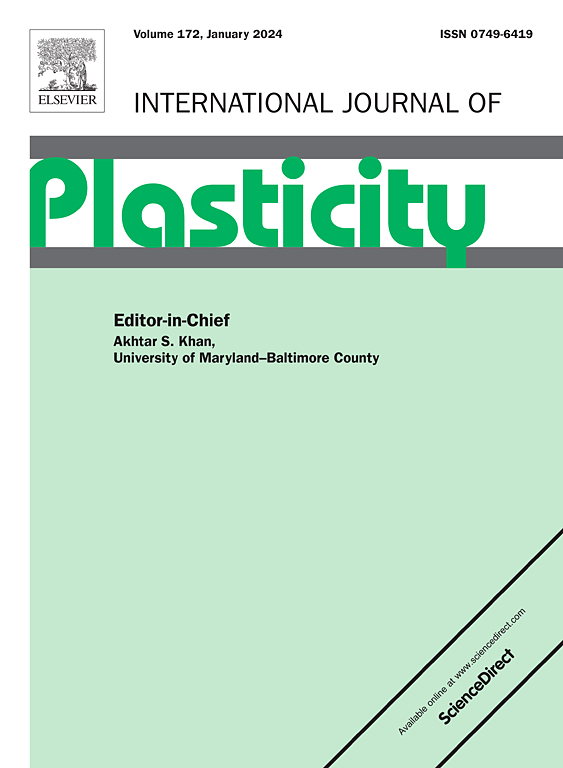Phase-specific tailoring strategy for synergetic and prolonged work hardening to achieve superior strength-plasticity in lamellar-structured alloy
IF 9.4
1区 材料科学
Q1 ENGINEERING, MECHANICAL
引用次数: 0
Abstract
The pursuit of alloys that integrate high strength and substantial plasticity persists across various industries. Nevertheless, alloys engineered for elevated strength commonly manifest unsustainable work hardening, ultimately leading to a decline in plasticity. Dual- or even multi-phase systems offer vast potential for novel microstructural engineering aimed at harmonizing these inversely related property requirements. Here, heterogeneous lamellar structure consisting of alternating austenite and ferrite lamellae is explored to decouple and leverage the distinct roles of individual phases in a dual-phase system. This phase-specific tailoring strategy meticulously manipulates intra-phase microstructure, and tunes the lamella thickness to promote both high initial strength and prolonged work hardening. The significantly enhanced strength benefits from pre-existing defects, interfaces strengthening and quasi isostrain deformation mode while high plasticity originates from relatively uniform strain partitioning between phases across a wide strain range achieved through exploiting various hardening components. For austenite, prolonged work hardening is achieved by sequential utilization of dislocation hardening followed by martensitic transformation hardening. Moreover, the martensite laths in favorable configuration along with the retained austenite contribute to retarding cracking. For ferrite, wide-range work hardening is ensured by expanding the potential for dislocation activities which lowers initial density and raises peak density through reducing the space in the thickness dimension. Such innovation elevates the traditionally inferior work-hardening capability of high-strength BCC structure to an exceptional level. The resultant alloy, while boosting nearly twice the yield strength of its conventional counterpart, exhibits a total elongation of 45 %. This strategy holds potential for broad application across dual- and multi-phase systems and proposes a new avenue for enhancing plasticity in high-strength lamellar-structured alloys.
层状组织合金协同长时间加工硬化的相位定制策略,以获得优异的强度塑性
对高强度和高塑性合金的追求贯穿于各个行业。然而,为提高强度而设计的合金通常表现为不可持续的加工硬化,最终导致塑性下降。双相甚至多相系统为旨在协调这些反向相关的性能要求的新型微结构工程提供了巨大的潜力。本文探讨了由奥氏体和铁素体交替片层组成的非均相片层结构,以解耦并利用双相系统中各个相的不同作用。这种针对相的定制策略精心控制相内微观结构,并调整薄片厚度,以提高初始强度和延长加工硬化时间。强度的显著提高得益于预先存在的缺陷、界面强化和准等应变变形模式,而高塑性源于利用各种硬化成分在宽应变范围内实现相间相对均匀的应变分配。对于奥氏体,通过顺序利用位错硬化和马氏体相变硬化来实现长时间的加工硬化。此外,良好形态的马氏体板条和残留的奥氏体有助于延缓开裂。对于铁素体来说,通过扩大位错活动的潜力来保证大范围的加工硬化,从而降低初始密度,并通过减小厚度尺寸中的空间来提高峰值密度。这种创新将传统上较差的高强度BCC结构的加工硬化能力提升到一个特殊的水平。所得合金的屈服强度几乎是常规合金的两倍,总伸长率达到45%。该策略具有广泛应用于双相和多相体系的潜力,并为提高高强度层状结构合金的塑性提供了新的途径。
本文章由计算机程序翻译,如有差异,请以英文原文为准。
求助全文
约1分钟内获得全文
求助全文
来源期刊

International Journal of Plasticity
工程技术-材料科学:综合
CiteScore
15.30
自引率
26.50%
发文量
256
审稿时长
46 days
期刊介绍:
International Journal of Plasticity aims to present original research encompassing all facets of plastic deformation, damage, and fracture behavior in both isotropic and anisotropic solids. This includes exploring the thermodynamics of plasticity and fracture, continuum theory, and macroscopic as well as microscopic phenomena.
Topics of interest span the plastic behavior of single crystals and polycrystalline metals, ceramics, rocks, soils, composites, nanocrystalline and microelectronics materials, shape memory alloys, ferroelectric ceramics, thin films, and polymers. Additionally, the journal covers plasticity aspects of failure and fracture mechanics. Contributions involving significant experimental, numerical, or theoretical advancements that enhance the understanding of the plastic behavior of solids are particularly valued. Papers addressing the modeling of finite nonlinear elastic deformation, bearing similarities to the modeling of plastic deformation, are also welcomed.
 求助内容:
求助内容: 应助结果提醒方式:
应助结果提醒方式:


